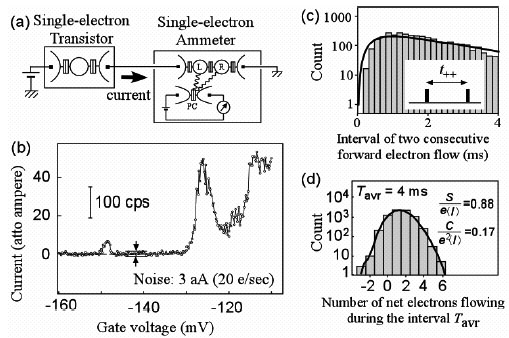Toshimasa Fujisawa
Physical Science Laboratory
We have developed a single-electron counting device, which measures the location of an electron in two quantum dots by using a point contact electrometer (see the frontispiece). For example, an average current can be obtained by counting the number of net electron flow in a given period. We have demonstrated such current measurement on a single-electron transistor as shown in Fig. (a). The obtained current shows Coulomb blockade oscillations as shown in Fig. (b), where noise level of about 3 atto-ampere is three or four orders of magnitudes smaller than that in a conventional ammeter.
In addition to the average current, various statistical analyses are also demonstrated. Figure (c) shows a histogram of the interval between two consecutive forward electron tunneling events (called forward recurrence time), where the reduction of the occurrence with zero interval suggests anti-bunching correlation. This appears from Coulomb interaction in the single-electron transport through the counting device. Moreover, Fig. (d) represents a histogram of the current measured in a short period Tavr (counting statistics), where higher order noise of the current are extracted to characterize the distribution of the current. We believe that various correlated transport can be examined with this technique.
[1] T. Fujisawa, et al., Science 312
(2006) 1634.
 |
||
|